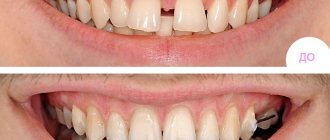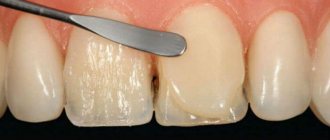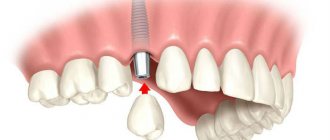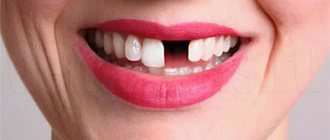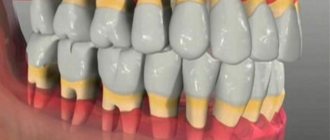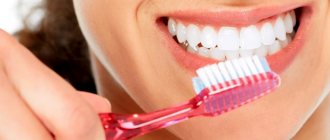Description of material
Metal-ceramic crowns are made from an individually made plaster cast and consist of a metal base and a ceramic surface.
The frame can be made from alloys of noble metals (gold, silver, palladium) or from base alloys (nickel, chromium, cobalt).
The strength of the structure is ensured by the frame, which fully performs the functions of the lost tooth. And thanks to the ceramic lining, the artificial tooth looks almost the same as a natural one.
To reduce the fragility of the crown , the technology of layer-by-layer application of ceramics to the outer surface of the metal is used, then securely fixed by sintering.
Although metal-ceramic structures are considered strong and durable, it is precisely on such products made from combined materials that chips most often form. This mainly occurs in people who prefer solid foods.
What is a metal-ceramic crown?
A “metal-ceramics” dental crown is an orthopedic structure consisting of a durable metal frame base, coated on the outside with a finishing layer of special dental ceramics.
The base is made of different metal alloys: titanium, nickel, gold and others. The ceramic coating is applied to the frame in layers, with each layer subjected to heat treatment. This technique ensures super-strong adhesion of the ceramic composition to the metal base.
Causes of damage
At the junction of the metal base and the ceramic lining, strong stresses sometimes occur, which can cause chips or other damage to the ceramic.
The main reasons for the formation of ceramic chips include:
- a large difference between the coefficients of thermal expansion of metal and ceramics;
- the intermediate part of the bridge structure is too long (bases made of noble metals have little rigidity, so with excessive chewing loads, chips on the surface may occur);
- malocclusion , sometimes in combination with pathological grinding of teeth;
- unprofessional tooth preparation (insufficient removal of hard tissues from the chewing surface);
- carrying out large-scale orthopedic work without the use of special equipment;
- the use of too thick cement to fix the metal-ceramic structure;
- entry of foreign bodies between the prepared tooth and the crown;
- poorly performed technical and laboratory work;
- injuries after a blow , fall, etc.;
- improper handling of artificial teeth by the patient (increased loads, temperature changes).
Technique for removing a crown from a tooth without damaging it and the devices used.
Come here if you want to take a closer look at the Noritake metal-ceramic crown.
At this address https://www.vash-dentist.ru/protezirovanie/nesemnyie-p/koronki-np/kachestva-metallokeramicheskih-duceram.html you will find reviews about Duceram metal-ceramic crowns.
Advantages and disadvantages
Like any type of orthopedic structures, metal-ceramic dental crowns have certain positive and negative qualities.
Pros of crowns
The advantages of crowns with a metal frame and ceramic outer coating are as follows:
- To install a prosthesis, there is no need to remove a natural tooth. It remains completely, with the exception of the layer ground to the thickness of the structure;
- metal ceramics can withstand high loads and maintain structural stability when eating solid foods;
- increased strength ensures the quality and durability of structures, which allows them to be installed on chewing teeth;
- with proper execution of products, there is no free space between the gums and the crown. The prosthesis turns out to be one-piece and fully corresponds to the structure of the natural tooth;
- the material is not dyed, so even with long-term use, the color of the coating does not change and does not distort the beauty of the smile;
- metal ceramics do not cause harm to the human body and are suitable for almost every patient;
- with proper care, structures made of metal alloys with a ceramic finish can last up to 15 years or more;
- caries does not form on the prosthesis, it is not a source of spread of harmful bacteria;
- external attractiveness. Metal-ceramic dentures imitate natural enamel as much as possible and are in no way different from natural teeth.
Speaking about the advantages, one cannot fail to mention the cost of the products, which is much lower in comparison with other types. When it comes to permanent prosthetics, metal-ceramics as a material is considered one of the best options.
Cons of crowns
Along with numerous advantages, the designs also have some disadvantages. These include:
- the need for depulpation of soft tissues and grinding of the hard enamel coating;
- under excessive loads, chips may appear on the ceramic layer;
- if the frame is made from inexpensive materials, then they can be translucent and such products will look unsightly on the front teeth;
- the possibility of allergic reactions in some patients due to individual intolerance to the constituent components.
In most cases, these disadvantages are invisible, and the prosthetics themselves allow you to achieve an excellent final result.
Restorative methods
It is important to know that a broken piece of ceramic should not be thrown away. It must be brought to the doctor, who will determine whether it can be replaced.
There are several ways to solve the problem, namely:
- Carrying out surface polishing. In this case, the shape of the tooth changes, but, nevertheless, its integrity and aesthetics are preserved. This method is one of the most economical. But it is unacceptable to use it if the teeth are located in the smile zone.
- Complete replacement of the structure. This is the most reliable method, but it requires a lot of financial costs. It also takes a lot of time to completely replace cermets.
- Restoration after removal. Since the crown is firmly fixed to the cement, it is very difficult to remove it. Professional skills and special tools are required to avoid damaging the product during removal.
- Repair without removal. This recovery method is the most popular. All manipulations are carried out directly in the patient’s mouth (the damaged piece is built up using composite materials). The downside of this type of repair is that the crown may not last very long.
If damage occurs as a result of trauma, restoration must be carried out as quickly as possible.
If there is a pronounced fracture line or a complete absence of ceramic coating, it is best to re-make the crown.
This type of damage usually occurs after poorly performed technical or laboratory work.
What to do if a chip occurs
Modern dentistry uses several methods of metal-ceramic restoration for chips, including without removing the structure. The most common method is polishing.
It is used for small chips, or if the chip has formed in an inconspicuous place, since the shape of the crown is irretrievably lost.
The advantage of using this method is its low cost.
The method consists of treating the damaged area with a rubber brush with a special composition. The areas between the teeth are treated with finishing plates.
Repairing a chip means replacing the crown. This is the most expensive and most reliable way:
- The screwed-in structures are drilled out;
- Metal-ceramic crowns fixed with glue are subjected to hardware processing and then removed.
- After the crown is removed, a control impression is made;
- The tooth is prepared (if necessary) and processed;
- A new product is manufactured according to the layout.
Restoration technique after removal
Repairing metal-ceramic structures is complex and requires strict adherence to technology. In order not to destroy the crown during removal, and to safely fix it in place after restoration, it is necessary to use special tools.
For example, the Coronaflex device allows you to remove the structure using compressed air. In this case, the crown is not damaged at all, but such a procedure requires large financial costs.
The method of de-cementing a structure using ultrasonic exposure also helps preserve the integrity of the product. But some materials are not susceptible to this effect (for example, glass ionomer cement).
The doctor can use special instruments with which he controls the force of the load on the tissue and the product:
- device with a hook-shaped tip;
- special forceps;
- separating bolt;
- pneumatic hand tools;
- crown removers manual or automatic.
As a rule, the structure is removed under local anesthesia, so the patient does not feel any discomfort.
After removal, the dentist gives the product to the dental technician in the laboratory. The restoration procedure for minor damage takes approximately 2-3 hours.
The specialist restores the original appearance of the product by gluing the missing piece using a special composition.
If a fragment is lost, a layer of ceramic is applied to the damaged area, after which the product is dried in a special oven, then sharpened and polished using special equipment.
This method is not very effective and there is a risk of damage to the crown during removal. In addition, it is possible that the structure will break again.
Restoration of a metal-ceramic crown with damage of any complexity
Medical offers services for the restoration of dental crowns in a short time. We provide comprehensive treatment, dental prosthetics, and repairs at affordable prices. The individual approach and professionalism of the staff, the use of only high-quality materials and modern technologies allows you to achieve an ideal smile and the health of your teeth.
VTV managers will tell you about the cost of crown restoration and scheduling a visit to the clinic’s specialists in the feedback form on the website or by phone.
Repairing the product in the patient's mouth
The restoration procedure is similar to placing a filling. It is important that the crown is dry. Therefore, first of all, the area that needs to be restored is isolated from moisture using a rubber dam.
Next, the doctor performs the following manipulations:
- The damaged area is prepared using a diamond bur. This is necessary to create a rough surface and form a bevel, as a result of which the composite material adheres better.
- The entire surface is cleaned with a brush, after which it is treated with a special acid for a minute . For metal ceramics, only hydrofluoric acid is used. Then the crown is washed with a stream of water, followed by drying.
- The ceramic surface is treated with silane , which dries instantly, and then with a primer.
- Several layers of opaque material are applied to the damaged area , which covers the metal. Then polymerization is performed with a special lamp for a few seconds.
- Finally, the specialist covers the area with adhesive , after which he applies layer-by-layer composite materials (dentin, enamel) of the required shade. Each layer is polymerized with a halogen lamp.
- The last stage is grinding, polishing the surface and removing the rubber dam . After completing all the work, the doctor evaluates the aesthetic result of restoring the metal-ceramic crown.
Composite materials have excellent masking characteristics, therefore, as a result of restoring ceramics using this method, the metal is not visible at all. And thanks to polishing, the tooth acquires a natural appearance.
If the procedure is performed by an experienced specialist, then any traces of the work will be completely invisible. The disadvantage of the method is that doctors do not provide guarantees regarding the durability of the crown after restoration.
What are the features of Vita metal-ceramic crowns and indications for their installation.
In this article we will discuss the price of titanium dental crowns.
Here https://www.vash-dentist.ru/protezirovanie/nesemnyie-p/stiranie-zubov.html we will talk about modern methods of eliminating tooth wear.
Indications for installation of metal ceramics
Dentists install crowns and bridges made of metal-ceramics in case of functional, anatomical or aesthetic inferiority of natural teeth.
The main indications for use include:
- destruction of natural crowns due to carious processes or traumatic factors, in which restoration with inlays or fillings is impossible;
- increased abrasion of tooth enamel;
- abnormalities in the development or incorrect position of the front teeth and other methods do not provide the desired effect in eliminating such anomalies;
- wedge-shaped defects of teeth in the smile area and fluorosis;
- changes in the color of tooth enamel and the inability to achieve whiteness using whitening technologies;
- absence of one or more units in the dentition;
- inconsistency of existing orthopedic structures in terms of functionality and aesthetics.
In some cases, metal-ceramic products are used for mild and moderate periodontitis as splinting structures.
Forecast
A restored crown can last a year or several years, depending on certain factors:
- size of the fracture (if the chip is too large, the risk of repeated destruction of the crown increases);
- base material (composite materials adhere better to ceramics than to metal);
- incorrect bite (in some cases, this factor causes re-formation of a chip);
- improper or poor quality dental care can lead to damage to the restored crown;
- long bridge structure (due to increased micro bends, damage to the restoration is likely);
- violation of the tightness of the adhesion of ceramics and metal (ceramics may lose their strength over time).
It is important to correctly determine the cause of the chip. For example, if a breakdown occurred due to a violation of the crown manufacturing technology, then it needs to be completely redone. Only by finding out the cause can the recurrence of the defect be avoided.
Caring for metal-ceramic crowns
Along with the fact that caring for artificial metal-ceramic teeth is quite simple, there are some rules that, if followed, can extend the service life of the products:
- You need to brush your teeth at least twice a day. Movements should be vertical, directed towards the tooth edge from the gum;
- The brush should have soft bristles. Any paste can be used according to the patient’s individual preferences;
- You should not limit yourself to just brushing, since food remains remain in the interdental spaces. To remove them, you need to use dental floss;
- After brushing, you should rinse your mouth with clean water and only then use an antiseptic mouthwash;
- Lovers of coffee or other coloring foods and drinks, as well as smokers, are recommended to have their teeth professionally cleaned at least twice a year. Whitening pastes will not provide a positive effect in caring for metal ceramics, so home whitening is not advisable.
In addition to hygiene procedures, you also need to know that strong mechanical loads can lead to cracks and chips in the ceramic coating. Also, sudden temperature changes worsen the condition of the dentures, so it is not recommended to eat excessively hot or very cold food.
Price
On average, the cost of restoring a chip on a metal-ceramic crown ranges from 2,500 to 4,500 rubles. Restoration using composite materials will cost approximately 3,000 rubles, and using solid inlays - from 4,000 rubles.
Re-polishing the restoration costs approximately 400 rubles, and making a new crown costs more than 10,000 rubles.
First of all, the price depends on the size and location of the damage. The qualifications of a specialist are of great importance. If the chip occurred as a result of an error by the dentist or dental technician, the patient does not pay for the repair.
The video presents a master class on intraoral repair of a prosthesis when the ceramic veneer is chipped.
How long does cermet last?
Dental crowns made from metal ceramics are quite durable. On average, the service life of products is at least 10-12 years. But patients who choose this type of prosthetics need to know that the service life directly depends on several factors:
- correct preparation of teeth for prosthetics. If the canals are filled with poor quality, inflammatory processes soon occur, the gums become swollen, and the patient feels severe pain. As a result, the dentures have to be removed, the tooth must be treated, and the denture must be made in a new way;
- orthopedic professionalism. It is very important that the doctor performs the grinding of hard tissues flawlessly. If irregularities and tubercles remain on the tooth, then the prosthesis will not fit tightly to the tooth tissue. Food, saliva and air enter the resulting gaps and very soon carious processes occur in such cases;
- experience and technical skill. It determines how closely the prosthesis matches the shape and shade of natural teeth.
By seeking prosthetic services at the Beryozka clinic in Balashikha, you can be sure that all stages will be performed flawlessly and you will receive a guarantee on the installed crowns.
Reviews
Most often, crowns are damaged after injury or due to improper dental care. Experts believe that it is necessary to restore chips as early as possible in order to avoid complete destruction of the product.
If you want to ask any questions about restoring the integrity of the crown or simply share your feedback, write them in the comments to this article.
If you find an error, please select a piece of text and press Ctrl+Enter.
Tags dental crowns metal-ceramic crowns fixed dentures
Did you like the article? stay tuned
Previous article
An anti-snoring mouthguard is a worthy alternative to surgery
Next article
On the rationality of coronoradicular separation
Why did the crown fall off?
There are many reasons that can provoke an unpleasant situation. According to statistics, the following happens most often:
- The crown fell off because the patient did not comply with operating conditions, such as biting hard food or shelling nuts.
- A mechanical injury occurred, the person fell or hit himself, which led to the crown falling out.
- A medical error was made; before attaching the prosthesis, the tooth was severely ground down, as a result of which it became an unreliable mount for the artificial product.
- The wrong size prosthesis was used, so the crown fell off the tooth.
- Incorrect attachment sequence of the artificial unit, for example, saliva was not sufficiently isolated when applying the adhesive.
We can conclude that the cause of a fallen crown can be not only the patient’s incorrect actions, but also the dentist’s oversight. To avoid this, we advise you to contact only trusted medical centers and highly qualified specialists.
